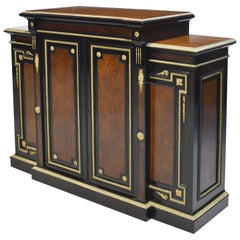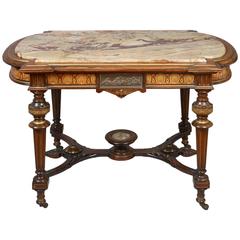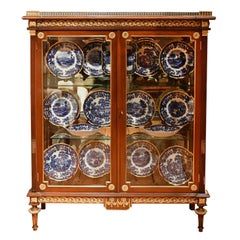Leon Marcotte
American Gilded Age NY Ebonized Credenza with Bronze Doré Ormolu Mounts
By Ringuet-Leprince and L. Marcotte
Located in Miami, FL
ormolu bronze doré mounts in the manner of NY cabinet makers Ringuet-Leprince, Marcotte and Co. The
Category
Antique Late 19th Century American Belle Époque Credenzas
Materials
Ormolu
$6,750
H 60.25 in W 66 in D 22.5 in
Louis XVI Style Gilt Bronze & Metal Mounted Rosewood Cabinet Vitrine P.E. Guerin
By P. E. Guerin
Located in Los Angeles, CA
makers such as Leon Marcotte and Pottier and Stymus. Both Herter Brothers and Pottier and Stymus used
Category
Antique Early 1900s North American Louis XVI Vitrines
Materials
Malachite, Metal, Bronze
$48,950 Sale Price
42% Off
H 55.25 in W 53.25 in D 14.5 in
Recent Sales
Center Table with Marble Top Attributed to Pottier and Stymus, New York
Located in Litchfield, CT
of New York City during the latter half of the 19th century such as Pottier & Stymus or Leon
Category
Antique 1870s American Aesthetic Movement Center Tables
Materials
Rosewood, Tulipwood
NYC Gilded Age Louis XVI Style Display Cabinet, Attributable to Leon Marcotte
By Ringuet-Leprince and L. Marcotte
Located in Miami, FL
Leon Marcotte, in mahogany with Fine brass ormolu mounts and gallery, beveled glass on front and side
Category
Antique 1880s American Louis XVI Vitrines
Materials
Brass
H 52 in W 44 in D 14 in
An Exceptional Napoleon III Cabinet with Large Hand Painted Sevres Plaques.
Located in Lambertville, NJ
. The cabinet by Famed architect cabinet maker and interior designer, Leon Marcotte. This piece was at
Category
Antique 1870s French Napoleon III Cabinets
Materials
Marble
H 44 in W 43 in D 16.5 in
19th Century Louis XVI Style Bed Converted to King-Size
Located in Miami, FL
. Originally a single bed that was attributable to Leon Marcotte and made in either New York or Paris (Marcotte
Category
Antique Late 19th Century French Louis XVI Beds and Bed Frames
Materials
Mahogany
French Belle Époque Table with Parquetry, Marquetry and Ormolu Mounts, 1870
Located in Miami, FL
Louis XV Belle Époque table for their chic New York clientele. Leon Marcotte was another cabinet-maker
Category
Antique 19th Century French Belle Époque End Tables
Materials
Ormolu
H 30.25 in W 41 in D 27.25 in
Important American Empire style Armoire
Located in Miami, FL
, Pottier & Stymus, Léon Marcotte, and Kimbel & Cabus. The foundry, still family owned, is on Jane Street in
Category
Antique 19th Century Cabinets
Materials
Bronze
Cabinet in Boulle Marquetry Stamped Ringuet, 19th Century
By Ringuet-Leprince and L. Marcotte
Located in Manduel, FR
Palace of New-York.
His brother Leon Marcotte moved to America in 1848. Thus, the two brothers opened a
Category
Antique Mid-19th Century French Napoleon III Cabinets
Materials
Tortoise Shell
People Also Browsed
Ancient Egyptian Monumental Temple Sphinxes
Located in London, GB
A pair of monumental limestone sphinxes of Pharaoh Nectanebo I, from the processional avenue of the Serapeum of Memphis, 30th Dynasty, circa 379 - 360 BC.
The sphinxes of the Serape...
Category
Antique 15th Century and Earlier Egyptian Egyptian Figurative Sculptures
Materials
Limestone
19th Century Meissen Porcelain 'Elements' Ewer Emblematic of Water
By Meissen Porcelain
Located in New York, NY
A 19th century Meissen porcelain 'Elements' ewer emblematic of water. Blue crossed swords mark. The present ewer, representing water, is after the set modelled by Johann Joachim Ka¨n...
Category
Antique 1870s German Rococo Vases
Materials
Porcelain
Tiffany & Company, George Paulding Farnham, A Rare, Lavish Silver Centerpiece
By Tiffany & Co., Paulding Farnham.
Located in Queens, NY
Tiffany & Company and George Paulding Farnham, A rare, lavish and monumental sterling silver centerpiece with original mirrored-glass sterling silver plateau, circa 1900.
Museum qua...
Category
Early 20th Century American American Classical Sterling Silver
Materials
Sterling Silver
$788,000 Sale Price
20% Off
H 15 in W 39 in D 34 in
Pair French 19th Century Neoclassical Style Figural Candelabra by Henri Picard
By Henri Picard
Located in Los Angeles, CA
A very fine pair of French 19th century neoclassical Greco-Roman style patinanted bronze and ormolu mounted figural candelabra by Henri Picard (French, Active from 1831-1864). The la...
Category
Antique 19th Century French Greco Roman Candelabras
Materials
Bronze, Ormolu
$29,850 Sale Price / set
38% Off
H 36.75 in W 18 in D 15 in
Louis XVI Style Bunk Beds/Matching Pair of Single Beds Made by La Maison London
By La Maison London
Located in London, Park Royal
Louis XVI style bunk beds, exclusive to La Maison London: Hand carved featuring a band of intricate laurel leaves along the side bars and hand finished to order (picture shows a pale...
Category
2010s British Louis XVI Beds and Bed Frames
Materials
Wood
$14,196 / set
H 87.01 in W 41.34 in D 88.59 in
Incredible 19th Century Meissen Porcelain Covered Urn Emblematic of Autumn
By Meissen Porcelain
Located in New York, NY
An incredible and truly monumental 19th century Meissen Porcelain Covered urn emblematic of autumn. This is one of the most incredible and spectacular displays of Meissen Porcelain w...
Category
Antique 1880s German Rococo Urns
Materials
Porcelain
$198,260
H 48 in W 32 in D 29 in
Four French Louis XV Style Gilt-Wood Carved & Chinoiserie Bergeres, Jansen Attr.
By Maison Jansen
Located in Los Angeles, CA
A Fine and Rare Assembled Set of Four French Louis XV Style Gilt-Wood Carved and Japanned-Chinoiserie Lacquer Decorated Bergers Armchairs, attributed to Maison Jansen (House of Janse...
Category
Antique Early 1900s French Chinoiserie Armchairs
Materials
Velvet, Giltwood, Lacquer
$33,950 Sale Price / set
20% Off
H 34.25 in W 24 in D 23 in
Fabergé Style Bejewelled and Enamelled Gold Egg by Asprey
By Asprey International Limited, Garrard & Co. Ltd.
Located in London, GB
This exceptional, 18 carat gold Easter egg was crafted by the famous London-based royal jewellers, Asprey & Co. The piece was then retailed by Garrard & Co, who once worked in collab...
Category
1990s English Decorative Boxes
Materials
Gold
Large George iv Silver Sideboard Dish, Made by Joseph Angell II, 1828
By Joseph Angell II
Located in London, GB
A large George IV silver sideboard dish, made by Joseph Angell II, 1828
English, early 19th century
Diameter 75cm, depth 10cm
This magnificent silver sideboard dish was made by ...
Category
Antique Early 19th Century English George IV Figurative Sculptures
Materials
Sterling Silver
surtout de tables bronze louis xvi style
Located in Los Angeles, CA
Surtout de table gilt bronze louis XVI style after the work of GOUTHIERE
This high end work is a master piece of a parisian bronzier of his time , probably by one of the best name o...
Category
Antique 1890s French Louis XVI Centerpieces
Materials
Bronze
An Italian 19th C. Marble Sculpture of "Flora's Embrace", By Professore F. Galli
By Fortunato Galli
Located in New York, NY
A Monumental Italian 19th Century Marble Sculpture of "Flora's Embrace", By Professore F. Galli. Flora's Embrace, an exquisite marble sculpture by the esteemed Professore Fortunato G...
Category
Antique 1890s Italian Belle Époque Figurative Sculptures
Materials
Carrara Marble
$145,000
H 54 in W 16 in D 14 in
French Mid 19th Century Louis XV St. Ormolu And Baccarat Crystal Chandelier
Located in West Palm Beach, FL
A sensational and grand scaled French mid 19th century Louis XV st. Ormolu and Baccarat crystal chandelier. The thirty light chandelier with a striking crystal central fut is surroun...
Category
Antique 19th Century French Louis XV Chandeliers and Pendants
Materials
Crystal
$198,000
H 59.5 in W 41 in D 41 in
Very Rare 19th Century Coromandel Veneered Year-Running Clock by Thomas Cole
By Achille Brocot, Thomas Cole (Clockmaker)
Located in London, GB
A Superb Coromandel-Veneered Mantle Clock
The case constructed of very well-figured Coromandel giving the maximum amount of decorative effect, with gilt bronze accents; the plinth...
Category
Antique 19th Century English Table Clocks and Desk Clocks
Materials
Brass, Ormolu
$118,889
H 23 in W 12.5 in D 12.5 in
Pair of French 19th Century Belle Époque Period Candelabra Lamps
Located in West Palm Beach, FL
A stunning and monumentally scaled true pair of French 19th century Louis XV st. Belle Époque period ormolu and patinated bronze candelabra lamps. Each extremely high quality seven a...
Category
Antique 19th Century French Louis XVI Table Lamps
Materials
Bronze, Ormolu
$52,500 / set
H 37 in W 15 in D 12 in
19th Century French Belle Époque Display Cabinet in the Manner of François Linke
By François Linke
Located in London, GB
A French Bijouterie
In the manner of François Linke
Designed in the Louis XV style and constructed in a wonderfully marked Kingwood, with precise and crisply cast ormolu mounts; ...
Category
Antique Late 19th Century French Louis XV Cabinets
Materials
Ormolu
$34,967
H 32.5 in W 27 in D 17 in
Gilt-Bronze and Vernis Martin Side Cabinet, by Zwiener
By Joseph-Emmanuel Zwiener
Located in Brighton, West Sussex
A fine Vernis Martin gilt-bronze mounted side cabinet with a marble top, by Joseph-Emmanuel Zwiener.
Stamped to the carcass beneath the marble top 'E. ZWIENER'.
This model of ...
Category
Antique 19th Century French Louis XV Cabinets
Materials
Bronze
Get Updated with New Arrivals
Save "Leon Marcotte", and we’ll notify you when there are new listings in this category.



